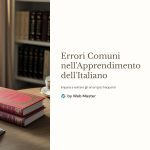 Learning Italian can be a rewarding yet challenging experience, especially for beginners. Many learners make similar mistakes that hinder their progress and fluency. Understanding these mistakes and learning how to correct them will significantly improve your Italian skills and confidence.
Learning Italian can be a rewarding yet challenging experience, especially for beginners. Many learners make similar mistakes that hinder their progress and fluency. Understanding these mistakes and learning how to correct them will significantly improve your Italian skills and confidence.

Confusing “Essere” and “Avere”
One of the most common mistakes beginners make is misusing the verbs “essere” (to be) and “avere” (to have). Unlike English, where “to be” is used in many cases, Italian often uses “avere” to indicate possession or states of being.
Incorrect:
- Io sono freddo. (I am cold.)
- Lei è fame. (She is hungry.)
Correct:
- Io ho freddo. (I am cold.)
- Lei ha fame. (She is hungry.)
To avoid this mistake, remember that physical states (hunger, thirst, cold, heat) use “avere”, not “essere.”

Mispronouncing Double Consonants
Italian pronunciation is distinct, and one key aspect is the correct pronunciation of double consonants. English speakers often fail to differentiate between single and double consonants, which can change the meaning of a word.
Examples:
- Anno (year) vs. Ano (anus)
- Nonno (grandfather) vs. Nono (ninth)
To fix this, exaggerate the pronunciation of double consonants at first and practice with words like “pizza,” “mamma,” “rosso.” Listen carefully to native speakers and mimic their pronunciation.

Overusing Subject Pronouns
In Italian, subject pronouns (I, you, he, she, etc.) are often omitted because verb conjugations indicate the subject. Overusing them makes speech sound unnatural.
Incorrect:
- Io vado al cinema. (I go to the cinema.)
- Tu vuoi un caffè? (Do you want a coffee?)
Correct:
- Vado al cinema. (I go to the cinema.)
- Vuoi un caffè? (Do you want a coffee?)
Drop the subject pronoun unless it’s needed for emphasis or clarity.

Struggling with Prepositions
Prepositions in Italian can be tricky since they don’t always correspond directly to English equivalents. The preposition “di” is commonly misused.
Incorrect:
- Vado a Roma di macchina. (I go to Rome by car.)
Correct:
- Vado a Roma in macchina. (I go to Rome by car.)
Common preposition mistakes include:
- “In” for means of transport (in macchina, in treno, in aereo).
- “A” for cities (a Roma, a Milano, a Firenze).
- “In” for countries and regions (in Italia, in Toscana).

Using the Wrong Gender for Nouns
Italian nouns have genders (masculine and feminine), and mixing them up is a frequent mistake.
Common Errors:
- La problema ❌ (Il problema ✅)
- Il mano ❌ (La mano ✅)
Some nouns end in -o but are feminine, and some in -a but are masculine. Learn irregular noun genders to avoid this mistake.

Forgetting to Conjugate Verbs Properly
Verb conjugation is crucial in Italian, and forgetting to conjugate verbs correctly can lead to confusion.
Incorrect:
- Io parlare italiano. (I speak Italian.)
- Lui andare a scuola. (He goes to school.)
Correct:
- Io parlo italiano. (I speak Italian.)
- Lui va a scuola. (He goes to school.)
Practice verb conjugation regularly, especially irregular verbs like essere, avere, andare, fare.
*Capturing unauthorized images is prohibited*


